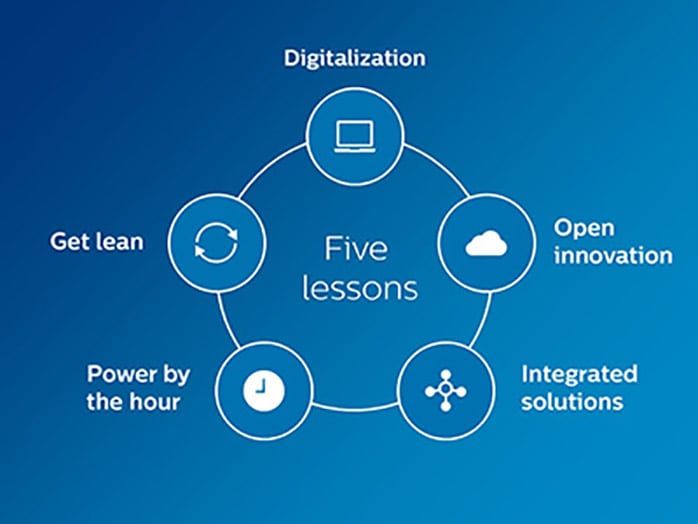Last week I was set the challenge to describe key lessons that Healthcare could learn from other industries – at the 2016 Annual HIMSS Conference & Exhibition. HIMSS is the world’s largest Health IT conference, attracting more than 40 000 healthcare IT professionals, clinicians, executives and vendors globally.
Here are five lessons based on my own experience:
1. Digitalization across the enterprise: Digitalization is enabling huge opportunities in healthcare innovation. Many of us entrust our financial health to the internet and now we are beginning to entrust our physical health to a cloud-connected environment.
Data, analytics and working digitally may seem commonplace but, as an industry we can still do much more to capitalise on its potential. E-commerce companies like Amazon offer inspiration as to how digital technology can further drive two transformative trends in health:
- Consumerization of health: analyzing personal health data, typically captured from wearables and other connected-sensors. Using this data, we can drive targeted, outcome-based, personalized models of care. This means driving a shift towards preventative medicine, improving the patient experience and quality of life.
- Industrialization of health: the design of scalable, repeatable processes and workflows to optimize care delivery. This is all about the coordination and integration of care: ensuring we build right-first-time ways of working – at scale.
Embracing digitalization, I’m convinced we will improve public health while also making the cost of managing healthcare more sustainable.
2. Open doors with open innovation: The complexity and scale of the digital health means we need to rethink how we innovate. It’s no longer the domain of the solitary researcher in a closed room. We cannot innovate in isolation, especially as our customers demand more integrated health systems.
Danish toy manufacturer Lego’s open-innovation experiment is a compelling example of the benefits of open innovation. After their Mindstorms programmable brick range was hacked by advanced-users, allowing unauthorized modifications, Lego embraced outside-in innovation.
The intelligence and creativity of "the crowd" vastly improved the original product – paving the way for formalized open-innovation practices across the business. More products were sold and Lego expanded into a lucrative new market addressing "grown-ups."
At Philips, we’re pursuing open innovation, for example by driving data standards for accelerated innovation in our open cloud infrastructure: the Philips HealthSuite Digital Platform and with co-create sessions with our customers.
3. Design integrated solutions: Healthcare innovation remains too narrow in its focus and ambition. Too much innovation happens only in limited silos, focused on just a few, (even single!) applications. Today, we should think much more in terms of integrated solutions – optimizing disease pathways – that improve productivity and outcomes.
Agricultural company John Deere pioneered this approach in its innovation model: engaging all stakeholders to understand customer and supplier challenges before applying integrated design solutions. In this way, the company is not just "selling machinery, but doing integral yield optimization.’’
For example, by combining technologies such as GPS positioning, soil sensors and self-driving machines in a connected-ecosystem, John Deere uses data analytics to make farming more precise and efficient through optimal fertilizer delivery. The goal is the best yield per square meter of farmland. This is “personalized medicine for the soil,” administered by farmers! High value services, at better cost and improved margin.
For our part, we’re building more and more outcome-based integrated solutions with our health systems customers to improve population health, covering everything from design, maintenance, finance and, of course, technology.
4. Measure everything: We do not need to reinvent the wheel in each and every healthcare system, but we must drive greater performance measurement. This means creating robust, repeatable and measurable processes that can be finessed to drive customer value.
Rolls Royce Aerospace’s “Power by the Hour” TotalCare model is one standout case study. Based upon predictability and reliability, Rolls Royce rigorously captures data on engine performance and service-model workflows, and interprets it in a continuous feedback loop. Data analysis enables preventative maintenance, customer work scope management and optimized scheduling of off-wing repair and engine overhaul activities.
Building customer trust through rigorous measurement and planning, this performance management system identifies and eliminates variance: a major challenge in health systems. And by monitoring patients during treatment we can close the loop in assessing treatment effectiveness.
Meanwhile, internally, giving employee’s access to information and accountability through measurement also nurtures a culture of continuous improvement whereby there is responsibility to optimize and improve processes beyond end to end.
5. Get Lean! Lean and continuous improvement, as in a world class business system, helps translate strategic intent into improved execution and results. With greater data transparency we can eliminate inefficiencies for better speed and performance.
Pioneered by Toyota and the automotive industry, Lean Six Sigma continuously improves workflows in a structured way by eliminating and identifying waste. For healthcare this could be interpreted as ‘’waiting times’’ or ‘’over-production’’.
Imagine the benefits to patient and provider of first-time-right scans. Or outcome-based care!
At its heart, being Lean is about speed and the relationship between steps in a process. It's about eliminating elements from any process that don’t add value. I remain convinced that we can continue to improve countless processes in healthcare systems globally. And within Philips of course!

